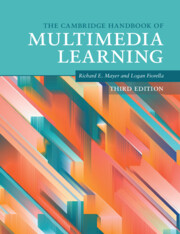Book contents
- The Cambridge Handbook of Multimedia Learning
- The Cambridge Handbook of Multimedia Learning
- Copyright page
- Contents
- Figures
- Tables
- Contributors
- Preface
- Acknowledgments
- Part I Background
- Part II Theoretical Foundations
- Part III Basic Principles of Multimedia Learning
- Part IV Principles for Reducing Extraneous Processing in Multimedia Learning
- 14 Principles for Reducing Extraneous Processing in Multimedia Learning
- 15 The Split-Attention Principle in Multimedia Learning
- 16 The Redundancy Principle in Multimedia Learning
- 17 The Signaling (or Cueing) Principle in Multimedia Learning
- 18 The Worked Example Principle in Multimedia Learning
- Part V Principles for Managing Essential Processing in Multimedia Learning
- Part VI Principles Based on Social and Affective Features of Multimedia Learning
- Part VII Principles Based on Generative Activity in Multimedia Learning
- Part VIII Multimedia Learning with Media
- Author Index
- Subject Index
- References
16 - The Redundancy Principle in Multimedia Learning
from Part IV - Principles for Reducing Extraneous Processing in Multimedia Learning
Published online by Cambridge University Press: 19 November 2021
- The Cambridge Handbook of Multimedia Learning
- The Cambridge Handbook of Multimedia Learning
- Copyright page
- Contents
- Figures
- Tables
- Contributors
- Preface
- Acknowledgments
- Part I Background
- Part II Theoretical Foundations
- Part III Basic Principles of Multimedia Learning
- Part IV Principles for Reducing Extraneous Processing in Multimedia Learning
- 14 Principles for Reducing Extraneous Processing in Multimedia Learning
- 15 The Split-Attention Principle in Multimedia Learning
- 16 The Redundancy Principle in Multimedia Learning
- 17 The Signaling (or Cueing) Principle in Multimedia Learning
- 18 The Worked Example Principle in Multimedia Learning
- Part V Principles for Managing Essential Processing in Multimedia Learning
- Part VI Principles Based on Social and Affective Features of Multimedia Learning
- Part VII Principles Based on Generative Activity in Multimedia Learning
- Part VIII Multimedia Learning with Media
- Author Index
- Subject Index
- References
Summary
The redundancy principle (or redundancy effect) suggests that redundant material interferes with rather than facilitates learning. Redundancy is broadly defined as any unnecessary information including irrelevant information, the same information presented concurrently in multiple forms or in unnecessarily elaborated form. According to cognitive load theory, processing redundant information with essential information increases working memory load which may interfere with learning. Eliminating such redundant information removes the requirement to process unnecessary sources of information. Accordingly, instructional designs that eliminate redundant material can be superior to those that include redundancy. This chapter summarizes research and theory concerned with the effect of processing redundant information in multimedia learning, a history of research in instructional redundancy, the conditions of applicability of this principle, and its instructional implications.
Keywords
- Type
- Chapter
- Information
- The Cambridge Handbook of Multimedia Learning , pp. 212 - 220Publisher: Cambridge University PressPrint publication year: 2021
References
- 5
- Cited by



